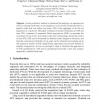654 search results - page 70 / 131 » On the Approximation of Computing Evolutionary Trees |
EVOW
2009
Springer
15 years 4 months ago
2009
Springer
The Maximum Parsimony problem aims at reconstructing a phylogenetic tree from DNA, RNA or protein sequences while minimizing the number of evolutionary changes. Much work has been ...
IPPS
2006
IEEE
15 years 3 months ago
2006
IEEE
This paper describes a parallel implementation of our recently developed algorithm for phylogenetic analysis on the IBM BlueGene/L cluster [15]. This algorithm constructs evolutio...
120
click to vote
CGI
2000
IEEE
15 years 2 months ago
2000
IEEE
We present a new approach for reconstructing a smooth surface from a set of scattered points in three-dimensional (3D) space. Our algorithm first decomposes a given point set int...
IJCV
2007
14 years 9 months ago
2007
This paper describes work aimed at the unsupervised learning of shape-classes from shock trees. We commence by considering how to compute the edit distance between weighted trees. ...
HPCC
2007
Springer
15 years 4 months ago
2007
Springer
A new evaluation method is presented that employs cut sequence set (CSS) to analyze fault trees. A cut sequence is a set of basic events that fail in a specific order that can indu...

